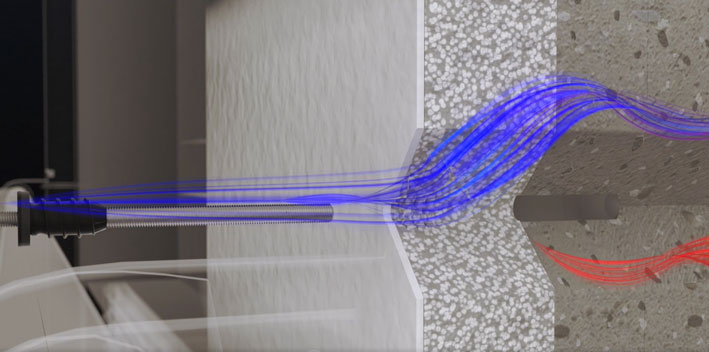Thermal bridging is what occurs when a material, or a part of it, conducts heat significantly more than all the other materials or areas around it, creating a sort of pathway that allows heat to escape. This disproportionate distribution of heat can result in unwanted cooler surfaces in these areas, which, in turn, could help build mold over time.
It normally affects conjunctions and spaces that are prone to openings like that of window frames and doors, but it can often be found in ceilings and walls as well.
What risks are associated with thermal bridges
Thermal bridges are considered a problem because they can potentially cause a series of different issues. They could, for instance:
- Increase internal and interstitial condensation
- As a result of constant heat loss and the area needing extra energy to be properly heated, raise operational costs
- Lead to spontaneous contractions and/or expansions
- Cause discomfort to those who occupy the area
- As mentioned earlier, create moist areas that can then help build-up mold and bacteria that are detrimental to our health
- Also as a result of the moist areas, damage to the materials that are used in a building putting the structural safety of the design at risk.
What causes thermal bridging
In essence, thermal bridging can be caused by three main factors: building design, material choice or installation techniques.
In terms of the first factor, certain designs are more likely to suffer from thermal bridging due to the way the conjunctions between an area and other are planned and ultimately constructed, so if many areas of a building are having thermal bridging problems, it may be due to the design itself.
The second factor, the material choice, refers to some materials having a tendency to conduct heat more than others, so including them in a design has to go hand in hand with a plan to prevent thermal bridging. Perhaps now you are wondering what materials could possibly be more prone to thermal bridging; maybe you are thinking ‘is wood a thermal bridge?’, or maybe even ‘is concrete a thermal bridge?’
The answer to both of those questions is a robust yes. Materials like wood and concrete especially are common examples of thermal bridges, but the occurrence of a thermal bridge in any of these materials can also be prevented.
Lastly, we need to consider the installation techniques. Something common that might be causing the thermal bridging in an area is a poor installation technique that leaves gaps between insulations; these create an unwanted air entryway which, simultaneously, serves as a heat escape route.
How to find a thermal bridge
Now, you can visibly detect some thermal bridges when they have already started causing some of the issues described above –perhaps you notice a damp stain in one of your walls or mold building-up between the union of a doorway and the floor.
But for other types, that at their early stages have caused barely (if any) damage, you might need to do some reckoning to ensure it is, in fact, a thermal bridge.
To do this, simply put one hand over the area you believe is affected and rub it a few times. Then, compare with the rest of the area, and if you sense a significant change of temperature, you could be in the presence of a thermal bridge.
How to prevent thermal bridging
The best way to avoid thermal bridges is to install thermal insulation boards to ensure a cohesive distribution of heat. In case of a severe thermal bridge issue, several boards can be layered for a better result; this is a technique called “lapped insulation”. It is also important to use the proper insulation fixings throughout the installation, to enhance durability.
When it comes to windows, it is best to select high quality spacers, preferably warm-edge ones, and to pair them with insulating glasses to avoid the thermal bridging.
All in all, preventing thermal bridging is all about selecting quality materials, and ensuring that every step of the construction project is carried with the utmost care and attention to detail; quality work and quality implements should join together to create the perfect result.


